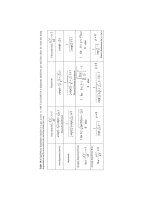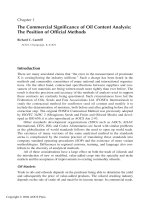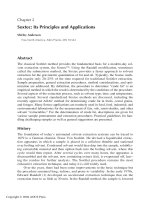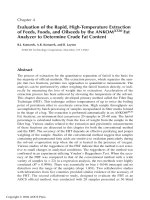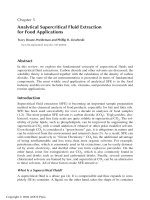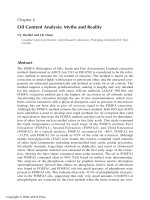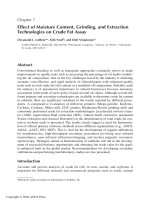oil extraction and analysis phần 10 pot
Bạn đang xem bản rút gọn của tài liệu. Xem và tải ngay bản đầy đủ của tài liệu tại đây (1.18 MB, 27 trang )
Chapter 10
Internet-Enabled Near-Infrared Analysis of Oilseeds
Ching-Hui Tseng, Kangming Ma, and Nan Wang
AgroSolution/QTA, Cognis Corporation, Cincinnati, OH 45232
Abstract
The near-infrared technique is used in the agricultural industry for fast and non-
destructive analysis of oilseeds. Current NIR systems have both advantages and dis-
advantages. To fully utilize the advantages of the current NIR systems but minimize
the disadvantages, an Internet-enabled NIR system was developed. This system
includes one central processor and an unlimited number of client NIR units. NIR
calibration models of different applications are developed and stored in the central
processor to be shared by all of the client NIR units. The instrument performance
of an individual client NIR unit can be monitored remotely, and most problems
can be solved remotely. The spectra obtained and the data analyzed are stored in
the central processor and can be accessed via the Internet for technique application
and business management. The combination of NIR and the Internet appears to be
a promising tool for oilseed analysis.
Introduction
The compositional analysis of oilseeds plays an important role in ensuring the
quality of oilseeds in both agricultural and food industries. Wet chemistry analyti-
cal methods of oilseeds are often time consuming, labor intensive, and expensive.
Different analytical methods are required for each oilseed parameter or trait of
interest. In addition, the analysis time of each method can be hours or days.
Classically, oilseed analysis requires Kjeldahl protein analysis, extraction, or pulsed
nuclear magnetic resonance (NMR) for total oil analysis, oven methods or moisture
meter for moisture analysis, gas chromatography (GC) or high-performance liquid
chromatography (HPLC) for fatty acid composition analysis, liquid-liquid extraction
and subsequent spectrophotometry for chlorophyll analysis, enzymatic hydrolysis
followed by colorimetric or spectrophotometric analysis for total glucosinolates
analysis, or HPLC for total and individual glucosinolates analysis. Unfortunately,
these methods often resulted in the destruction of the sample during the analytical
process. NMR has been used for nondestructive whole-seed analysis, and the tech-
nique is rapid and accurate. However, it has been used only in the analysis of total oil
and moisture in seeds.
Copyright © 2004 AOCS Press
Near-Infrared Applications for Oilseeds Analysis
Agricultural applications of near-infrared spectroscopy (NIR) started when Karl
Norris applied the statistical regression data analysis method in NIR diffuse
reflectance studies in the 1960s (1). Since then, much NIR-related research and appli-
cations have been reported for oilseed analysis. NIR is a rapid, nondestructive, inex-
pensive, and accurate method for the analysis of traits and material characteristics in
seeds, grains, and other types of materials. In addition, modern NIR is capable of pro-
ducing multiple results from a single analysis of intact samples. Among the oilseeds,
soybeans are not only an important animal feed but also a valuable human food
source because of their nutritional benefits and high oil and protein contents. Much
effort has been spent on NIR soybean analysis over the years. In earlier times, seed
grinding was often required, and sometimes other treatment was required to form a
paste type of sample form. In 1968, Ben-Gera and Norris used NIR to measure the
moisture content of soybeans (2). Hymowitz in 1974 (3) and Rinne in 1975 (4)
reported NIR oil and protein determination of soybeans.
In Asian countries, soybeans and soybean-derived products play important
roles in the food market. Protein, oil, and moisture contents affect their usefulness
in processing for different types of traditional foods such as tofu, miso, and natto.
Intact soybean analysis for fat, protein, and moisture is preferred (5). The impor-
tance of nondestructive analysis is that it can save considerable labor and time. The
health benefits of soybean-derived food products make it a more and more impor-
tant and popular food source in other regions as well. Enhancing the quality of pro-
tein and oil content has played an important role in soybean crop improvement.
NIR analysis of amino acid and fatty acid composition will benefit the breeding
process and commercial soybean testing. Pazdernik (6) compared the whole seed
and ground soybean NIR analysis for 17 amino acids and 5 fatty acids and demon-
strated that more accurate results were obtained with ground samples.
Sunflower is another important class of oilseeds. The nutritional benefits of sun
butter make it an attractive alternate for people who are allergic to peanut butter.
Studies have reported on the NIR determination of sunflower’s moisture, oil, protein,
and fiber contents (7,8). The nondestructive property of NIR allows the seeds to be
analyzed before germination. In addition, the analysis of the fatty acid composition of
machine-husked sunflower seeds was reported (9). Perez-Vicha explored the use of
intact sunflower seeds and compared it with other types of sample forms for NIR
analysis of oil content and fatty acid composition (10). Sunflower oil, husked seeds,
and meal all gave excellent correlations (r
2
= 0.90–0.99), whereas intact seeds gave
lower NIR correlations (r
2
= 0.76–0.85). Despite the lower correlations, NIR can be
used as a prescreening tool due to its convenience.
Rapeseed and related seeds are another important class of oilseeds. Antinutritive
compounds such as glucosinolates and sinapic acid esters (SAE) in the rapeseed and
related Brassicaceae family may affect the nutritional value of Brassica meal and
limit its use as a high-quality protein source. Nondestructive NIR was used to
Copyright © 2004 AOCS Press
search for both germplasm and breeding Brassica materials with reduced SAE con-
tent (11,12). The lowest SAE samples were analyzed by a reference method, which
confirmed the low SAE levels. Glucosinolate and erucic acid contents were simul-
taneously determined using intact rapeseeds on both reflectance and transmittance
NIR spectrometers (13). The NIR analysis of glucosinolate content gave accept-
able accuracy compared with the wet chemistry colorimetric method. NIR analyses
for oil, protein, glucosinolates, and chlorophyll were developed and compared on
three whole-seed analyzers (14). No significant differences were found between
the instruments for oil [standard error of prediction (SEP) 0.43–0.55%], protein
(SEP 0.35–0.42%) and glucosinolates (SEP 2.4–3.8 µmol/g). However, it was
shown that only one instrument could effectively analyze chlorophyll. For intact
rapeseed samples, NIR was used as a rapid method to estimate fatty acid composi-
tion (15). Excellent correlation with GC results was obtained for oleic, linolenic,
and erucic acids for all sample sizes. Calibrations for the other fatty acid compo-
nents were less accurate.
For intact Ethiopian mustard-seeds, NIR fatty acid composition analysis gave
high accuracy and correlation for the major acids, i.e., oleic, linolenic, linoleic, and
erucic (16). The ability of NIR to discriminate among different fatty acid profiles
was likely due to changes within six spectral regions: 1140–1240, 1350–1400,
1650–1800, 1880–1920, 2140–2200, and 2240–2380 nm. All six regions are asso-
ciated with fatty acid absorbers.
Over the years, other types of oilseeds have also been studied using the NIR
technique. Cottonseed is a major oilseed in domestic and international markets.
Products derived from cottonseeds are an important part of cotton production. A
rapid method for oil content analysis of cottonseeds in cotton breeding and testing
is desirable. Kohel attempted to use NIR to measure cottonseed oil content (17).
The calibration model gave good correlation, but when tested for unknown sam-
ples, the results were not acceptable. It has been reported that NIR has been used
for ground and intact flaxseed oil analysis (18). The calibration using whole
flaxseed was equal in precision to that of the ground samples.
Single-seed analysis is another area of interest, especially for breeding pro-
grams. For crop improvement, a large number of seeds in small quantities and even
single seeds must be evaluated. Because NIR is a rapid, inexpensive and nonde-
structive analytical technique, it is very useful in this area. It can often simultane-
ously produce analytical results for multiple traits and properties. To be useful in
breeding programs, the analytical results must be precise and accurate enough for
genetic segregate separations. The selected seeds with desirable traits can then be
used in the germination process for the next step in development. In 1999, Velasco
reported a study of simultaneous NIR analysis of seed weight, total oil content, and
fatty acid composition in intact single rapeseed (19). Excellent correlation was
found for oleic (r = 0.92) and erucic (r = 0.94), but not for linoleic (r = 0.75) and
linolenic (r = 0.73). In 1992, Orman studied the nondestructive prediction of oil
content in single corn kernels using NIR transmission spectroscopy (NITS) (20).
Copyright © 2004 AOCS Press
NIR Calibration Model Development
Before an NIR spectrometer can be used to predict any compositional property of any
oilseed, it must have a calibration model (or equation) for that property. To build a
good calibration model (or equation), a large set of sample seeds covering all of the
possible sample variances such as concentration variance, variety variance, color, size,
growing season, growing year, growing location, or moisture level with reliable chem-
ical data obtained from a standard or an official primary method is required. After
measuring the NIR spectra of the sample seeds, a calibration model can be built using
any Chemometric tool such as multiple linear regression (MLR), partial least squares
(PLS) regression, or artificial neural network (ANN) from the NIR spectra and prima-
ry data obtained (21–23). This calibration model can then be used to predict the NIR
spectrum of an unknown oilseed. For example, if a NIR calibration model has been
built for the analysis of total oil in soybean, it can then be used to predict the total oil
of an unknown soybean sample using the NIR spectrum obtained.
Advantages and Disadvantages of the Current NIR Systems
NIR has many advantages for use in oilseed analysis as described previously, but there
are also some problems that limit its capability for oilseed analysis. To lower the price
and simplify the operation, some NIR manufacturers provide only a single-component
NIR analyzer such as a moisture analyzer, protein analyzer, or oil analyzer. Most of
them are filter-type NIR systems that have few filters with wavelengths related only to
a specific component. Also, there are some low-cost NIR analyzers with the capability
of multicomponent analysis. The NIR manufacturers usually provide calibration mod-
els for some common traits such as moisture, oil, or protein, for some common grains.
These NIR systems use low-cost silicon detectors that detect light in the short-wave-
length NIR (SWNIR) region from 850 to 1050 nm as shown in Figure 10.1. The
SWNIR region usually has broad spectral features with very low absorption coeffi-
cients. Therefore, in most cases, they are used only to analyze total amounts of mois-
ture, oil, and protein. If more specific structural properties or components such as
iodine value, individual fatty acids, amino acids, or trans-fat, for example, are needed,
a more powerful NIR system will be required. Due to the low absorption coefficients
of SWNIR, the sampling method of this type of NIR system is usually designed to use
transmittance measurements (Fig. 10.2) rather than reflectance measurements (Fig.
10.3) to enhance the spectral features. There is the concern that different grains may
have different colors or sizes, and the color and the size of the oilseeds can affect the
penetrating ability of incident light. Generally, the darker the color or the smaller the
size, the lower is the penetration efficiency. Therefore, a different sample container
with a different sample path length may have to be substituted if a different grain must
be analyzed.
Because of the hardware variances such as light source variance, mechanical
variance, optical variance, and detector variance among different NIR systems, the
calibration models provided by the instrument manufacturer usually have to be recali-
Copyright © 2004 AOCS Press
brated before use. In most cases after a period of time of use, these models also have
to be recalibrated. This is because the spectral quality can be affected by the light
source decay or the drift of the optical alignment, which in turn affects the prediction.
Users normally do not know when and how much the prediction value has shifted
until a calibration expert runs the standard samples for a calibration check.
Other than the simplified NIR analyzers, there are also many fully functional NIR
systems available on the market. They usually cover a wide spectral range, have a
nm
Absorbance units
Fig. 10.1. NIR spectrum of wheat measured from 850 to 1050 nm.
Fig. 10.2. Transmittance measurement.
Copyright © 2004 AOCS Press
good signal-to-noise ratio, good wavelength accuracy, and are capable of analyzing
more materials and traits. However, this kind of NIR system is usually more expensive
and not suitable for use in the field or in an “unfriendly” environment. In addition, the
user has to be well trained for model development and maintenance. Even if the user
has been well trained or has a good background in spectroscopy and Chemometrics,
there is still no guarantee that the calibration models are rugged enough without drift.
In most cases, different laboratories build their own calibration models according to
the primary data from their own resources. Of course, it is inevitable that there are
biases among different laboratories even when the same primary method was used.
The primary method may also differ, i.e., the oil content of an oilseed can differ after
different extraction processes. Also, the weight percentage of a trait can be recorded
using different moisture bases, such as “as is,” dry base, or 13.5% moisture. Therefore,
the prediction value of the same trait in the same sample can be different from differ-
ent NIR systems in different laboratories.
An Emerging Trend: NIR Network and Internet-Enabled NIR System
To fully utilize the capability of NIR technology but retain the simplicity of operation
and maintenance, a NIR network concept was introduced. The network consists of one
central processor and many NIR analyzers (Fig. 10.4). Actually, there is no specific
limit for the number of individual analyzers. It depends on the computing capability of
the central processor. The individual NIR analyzer measures the spectrum of the
oilseeds. The spectrum obtained is sent to the central processor for storage and calcula-
tion. The calculated result is then stored in the central database and sent back to the
individual analyzer for display. Any authorized computer connected to the network
can also access the database of the central processor to obtain the results or spectra
measured by any specified NIR analyzer or group of specified analyzers. The NIR net-
work can be within an organization or a private company. It can also be the entire
Internet and becomes an Internet-enabled NIR system.
Advantages of the NIR Network
Within the NIR network, a rugged and fully functional NIR system can be used as
the individual analyzer because the users of the individual analyzers do not have to
develop application methods and maintain them. The only critical function of the
Fig. 10.3. Reflectance measurement.
Copyright © 2004 AOCS Press
analyzer is to measure the NIR spectrum and communicate with the central proces-
sor. The calibration models can be developed remotely by spectroscopic experts
and stored in the central processing computer. There is only one calibration model
developed and stored in the central processor for the same application used by all
individual analyzers. Therefore, there is no primary data bias among different ana-
lyzers. However, there may still be hardware and optical bias between different
systems. The accuracy of spectral wavelengths significantly affects the accuracy of
NIR predictions. A Fourier transform near-infrared (FT-NIR) system has better
wavelength accuracy than other types of NIR systems; hence, it is a good candidate
for the analyzer used in a NIR network. It also has the advantage of adjustable
spectral resolutions. Figure 10.5 shows NIR spectra of ground sunflower seeds
measured by a FT-NIR system with different spectral resolutions.
It is obvious that a NIR spectrum with a lower spectral resolution exhibits a
better signal-to-noise ratio and a NIR spectrum with a higher spectral resolution is
noisier if the sample measuring times are the same. Therefore, if an application
requires a better signal-to-noise ratio to distinguish minor concentration differ-
ences, a low-resolution measurement can be applied. A high resolution can also be
applied if an application requires detailed spectral feature identification. Of course,
it is difficult for general users to know how to choose optimal measurement para-
meters for a FT-NIR system. However, with the NIR network, all of the methods
can be developed remotely by experts at the central processor end and used by all
of the individual analyzers. Because the application methods can be developed
remotely and the individual analyzer is a high-performance NIR system, there is no
limit to the applications for each analyzer.
Fig. 10.4. NIR network.
Copyright © 2004 AOCS Press
It is also possible for the central experts to monitor instrument performance
from the spectra transferred to the central processor. If any problem were to devel-
op with the individual analyzer, remote diagnosis and possible problem-solving
can be processed from the central location. As previously described, to build a
robust oilseed calibration model, the calibration samples should cover all of the
possible sample variances. However, it is always difficult to obtain a sufficient
number of representative calibration samples covering all the possible sample vari-
ances while building a calibration model. The oilseeds produced this year may
have a different sample matrix than the previous year’s matrix. A dry year may
produce oilseeds different from those in a wet year. Therefore, a calibration model
of oilseeds may have to be updated periodically or when the prediction error is not
acceptable until the calibration model is robust with the analysis of all of the possi-
ble samples analyzed. With the NIR network, all of the models can be updated for
all of the analyzers simultaneously, if necessary.
Another advantage of the NIR network concerns data storage and data distrib-
ution. Because the spectra obtained by the analyzer are not stored locally, it will
never run out of the storage space and there is no need to back up spectral data
from the individual analyzer. With all of the data stored in the central computer,
the data can be distributed to or accessed by any authorized computer connected to
the network. If the central computer is connected to the Internet, the data can then
Fig. 10.5. NIR spectra of sunflower with different resolutions.
Copyright © 2004 AOCS Press
be distributed to or accessed from any Internet-connected computer throughout the
world. In addition, once the data have been backed up from the central computer,
the data from all the NIR network analyzers have also been backed up.
Of course, the central processor is the most important part of the NIR network.
It should have the capability of taking care of all of the model prediction work
from all of the analyzers and storing all pf the spectra and results in specified data-
bases. PLS (Partial Least Squares), an excellent algorithm for the linear correlation
modeling, and ANN (Artificial Neural Network), an excellent algorithm for the
nonlinear correlation modeling, are two examples of algorithms that can be used to
build the calibration models that are used by all of the NIR analyzers. It is also
possible that in the future, a newly developed Chemometric algorithm will do a
better job than all of the current existing algorithms for the calibration modeling. If
the central processor were to be upgraded with the capability of the new
Chemometric algorithm, all of the analyzers would also have this capability.
Therefore, the data treatment or modeling technology of the NIR network has no
limit.
Calibration model sharing
NIR prediction values are determined by the NIR spectrum obtained from the sam-
ple analyzed. Figure 10.6 shows the configuration of a dispersive type NIR system
and Figure 10.7 shows the configuration of a FT-NIR system. They both indicate
that the NIR spectrum of a sample can be affected by many factors such as the NIR
light source, the slits (or aperture), the mirrors (or lens), the grating (or beam split-
ter), the factors within the optical path (temperature, humidity, dust), the sample
material (variety, size, color, dryness), the sampling device (sample container,
fiber optics, or fiber probe), or the detector. To have identical NIR spectra, all of
the previously described factors would have to be identical. Without considering
the sample variances, instrument variances will always exist. NIR instrument man-
ufacturers are trying to make all instruments of one type more alike, but it is
impossible to have truly identical instruments. This is why the same calibration
Fig. 10.6. The configuration of a dispersive NIR system.
Copyright © 2004 AOCS Press
model used by different NIR systems of the same type may produce the prediction
values with bias. Normally, a set of standard samples covering the calibration con-
centration range is used to adjust the bias and slope of a calibration model for an
individual NIR system. Therefore, a standard calibration model of the same appli-
cation may be different in different NIR systems. Once a modification of the model
is necessary for some specific reason, it is necessary to modify it for all of the indi-
vidual NIR systems that use the same calibration model. As previously described,
the calibration models for the NIR network are stored in the central processor and
shared by all of the network analyzers. It is very important that these models pre-
dict consistent results for the same sample from different analyzers. Of course, it is
impossible to have identical predictions from all of the individual analyzers.
However, the prediction errors from any individual analyzer should be within the
95% confidence level (or twice the prediction of standard error) of a calibration
model.
Figure 10.8 shows the background spectra of 15 FT-NIR systems. These FT-
NIR systems are of the same brand and the same type, and all are equipped with an
integrating sphere with a lead sulfide (PbS) detector. The spectra were measured
on the gold-coated metal plate as the reflectance background with the spectral reso-
lution of 8 cm
–1
and spectral range from 4000 cm
–1
(2500 nm or 2.5 µm) to 10,000
cm
–1
(1,000 nm or 1.0 µm). The background spectra indicate that the PbS detector
has the highest sensitivity at ~4800 cm
–1
and the sensitivity decreases when the
wavenumber increases (or the wavelength decreases), but all of the background
spectra differ somewhat from each other. The lower intensity of some of the spec-
tra along the whole spectral region indicates that the output of the light source is
Fig. 10.7. The configuration of an FT-NIR system.
Source
Copyright © 2004 AOCS Press
lower, the optical throughput is lower, or the sensitivity of the detector is lower.
Some of the background spectra exhibit obvious moisture features between 5200
and 5500 cm
–1
, indicating that some instruments have high humidity along the
optical path.
Figure 10.9 shows the raw reflectance NIR spectra of the same canola seeds
measured by the previously described 15 FT-NIR instruments using the same mea-
surement parameters as the background spectra in Figure 10.8. Accordingly, the
spectra are obviously different from each other. Therefore, if a calibration model
was built using the spectra obtained from only one instrument, the prediction of the
same sample measured by another instrument using the same calibration model
might be very different. Normally, the raw reflectance NIR spectra from a FT-NIR
instrument are not used directly to build the calibration model or predict the result
for quantitative analysis.
In most cases, absorbance spectra are used to build the calibration model or
predict by a calibration model. The absorbance spectrum is defined as:
Absorbance spectrum = –log (raw spectrum/background spectrum)
It indicates that some of the background variances from different instruments can
be ratioed out and removed. Figure 10.10 shows the absorbance spectra converted
from the raw reflectance spectra in Figure 10.9. It is obvious that many of the spec-
Fig. 10.8. The background spectra of 15 FT-NIR instruments.
Wavenumber cm
–1
Single channel
Copyright © 2004 AOCS Press
Fig. 10.9. Raw reflectance NIR spectra of the same canola sample obtained from 15
FT-NIR instruments.
Wavenumber cm
–1
Single channel
Fig. 10.10. Absorbance NIR spectra converted from Figure 10.9.
Wavenumber cm
–1
Absorbance units
Copyright © 2004 AOCS Press
tral variances have been removed or reduced. For example, the moisture features
between 5200 and 5500 cm
–1
have been removed and the shapes of all of the spec-
tra have become similar. However, the offset and ramp between the spectra still
obviously exist. Some data treatment techniques such as 1st derivative, 2nd deriva-
tive, multiplicative scatter correction (MSC), or vector normalization can be used
to reduce the offset and ramp (24). Because vector normalization is going to be
used in the following discussion, a short description of this technique is presented.
During the process of vector normalization, the average y-value of the spectrum is
calculated first. This average value is then subtracted from the spectrum so that the
middle of the spectrum is pulled down to y = 0. The sum of the squares of all y-val-
ues is then calculated and the spectrum is divided by the square root of this sum.
The vector norm of the resultant spectrum is defined to be 1. Figure 10.11 shows
the spectra in Figure 10.10 after the treatment of vector normalization. It is obvious
that these spectra are much more alike than the spectra in Figures 10.9 and 10.10.
However, they are still not identical, and the prediction values of a calibration
model may still be different. Actually, this situation may be sufficiently accurate in
some cases, e.g., when the spectral change obviously changes with the concentra-
tion change of a specific trait, the prediction error due to the instrument variation is
not critical, or if the analysis is only for screening purposes, the prediction accura-
cy may not be of great importance. For example, a PLS calibration model of oil
Fig. 10.11. Spectra in Figure 10.10 after vector normalization.
Wavenumber cm
–1
Absorbance units
Copyright © 2004 AOCS Press
content in canola seeds was built using 150 NIR spectra obtained from a FT-NIR
system without any data pretreatment except the mean center calculation. The cali-
bration result shows an R
2
(determination coefficient) of 97.19% and RMSECV
(Root Mean Squared Error of Cross Validation) of 0.43% with the oil content rang-
ing from 40.9 to 52.0%. Two samples with the oil content of 47.5 and 45.2% were
measured in duplicate by 14 other FT-NIR systems. The prediction errors are
shown in Table 10.1 and illustrated in Figure 10.12. Most of the prediction errors,
except for four predictions, are still within twice the standard error of the calibra-
tion. This calibration model can be shared by different FT-NIR instruments if such
prediction errors are acceptable. However, if the spectra are pretreated with vector
normalization, a new PLS calibration model can be built with an R
2
of 96.85% and
RMSECV of 0.46%. In this case, the calibration does not appear to be as good as
the calibration model without the data treatment, but it can be used to predict the
spectra obtained from different FT-NIR instruments with much smaller prediction
errors. Table 10.2 shows the prediction errors of the same spectra in Table 10.1,
and Figure 10.13 illustrates the errors with a graph. It is clear that all of the predic-
tion errors are within twice the standard error of the calibration. The model can
then be shared by different FT-NIR systems without difficulty.
This is not always the case, however. If the spectral change is not obvious with
the concentration change of a specific trait, the prediction error due to the instru-
ment variation becomes critical. For example, a PLS calibration model of linolenic
TABLE 10.1
Prediction Errors of the Oil Content of Two Samples Measured by 15 FT-NIR Systems
Using the PLS Model Without Data Pretreatment
Prediction errors
Sample 1 (47.5% oil) Sample 2 (45.2% oil)
Instrument Measure 1 Measure 2 Measure 1 Measure 2
M101 0.66 0.28 0.56 0.63
M102 0.15 –0.37 –0.16 –0.19
M104 –0.45 –0.22 –0.34 –0.53
M105 –1.35 –0.58 –0.26 –0.10
M108 0.00 0.44 0.39 –0.23
M109 –0.48 –0.41 –0.98 –0.82
M113 –0.63 –0.49 –0.84 –0.70
M115 –0.46 –0.43 –0.68 –0.39
M118 –0.09 0.03 0.50 –0.22
M119 0.99 0.60 0.25 0.11
M120 –0.31 –0.23 0.31 0.41
M122 –0.84 –0.20 –0.38 –0.61
M124 –0.21 –0.33 –0.44 –0.85
M125 –0.37 –0.47 –1.04 –0.52
M129 –0.21 –0.31 –0.44 –0.72
Copyright © 2004 AOCS Press
acid content in canola seeds was built using 150 NIR spectra obtained from a FT-
NIR system without any data pretreatment except the mean center calculation. The
calibration result showed an R
2
of 96.69% and RMSECV of 0.22% with linolenic
acid content ranging from 1.88 to 7.82%. Two samples with linolenic content of
Fig. 10.12. Graph of the prediction errors in Table 1.
TABLE 10.2
Prediction Errors of the Oil Content of Two Samples Measured by 15 FT-NIR Systems
Using the PLS Model with Vector Normalization Pretreatment
Prediction errors
Sample 1 (47.5% oil) Sample 2 (45.2% oil)
Instrument Measure 1 Measure 2 Measure 1 Measure 2
M101 0.22 –0.03 0.53 0.36
M102 –0.34 –0.73 –0.20 0.00
M104 –0.13 –0.30 0.24 0.17
M105 –0.14 –0.12 0.56 0.59
M108 –0.18 –0.08 0.38 0.09
M109 –0.14 –0.18 –0.01 –0.09
M113 –0.19 –0.04 0.02 0.06
M115 –0.04 0.20 0.35 0.23
M118 –0.17 –0.18 0.21 0.02
M119 0.53 0.07 0.28 0.38
M120 –0.18 –0.20 0.08 0.26
M122 –0.37 0.00 0.27 –0.27
M124 –0.21 –0.23 0.06 –0.17
M125 0.14 –0.10 –0.03 0.22
M129 0.14 –0.10 0.33 0.08
Copyright © 2004 AOCS Press
1.89 and 5.22% were measured in duplicate by 14 other FT-NIR systems. The pre-
diction errors are shown in Table 10.3 and illustrated in Figure 10.14. There are
many predictions with errors more than double the standard error of the calibra-
tion. This calibration model should not be shared by different FT-NIR instruments.
Fig. 10.13. Graph of the prediction errors in Table 2.
TABLE 10.3
Prediction Errors of Linolenic Acid Content of Two Samples Measured by 15 FT-NIR
Systems Using the PLS Model Without Data Pretreatment
Prediction errors
Sample 1 (1.89% linolenic) Sample 2 (5.22% linolenic)
Instrument Measure 1 Measure 2 Measure 1 Measure 2
M101 –0.39 –0.28 –0.22 –0.19
M102 0.01 0.11 –0.03 –0.07
M104 1.10 1.08 1.09 1.03
M105 –0.10 –0.14 0.17 0.07
M108 0.91 0.68 0.63 0.65
M109 0.85 0.85 0.81 0.78
M113 0.10 0.11 –0.10 –0.13
M115 0.28 0.14 0.33 0.31
M118 0.23 0.23 0.36 0.21
M119 0.81 0.89 0.87 0.73
M120 0.79 0.77 0.84 0.82
M122 0.39 0.35 0.37 0.27
M124 0.62 0.72 0.66 0.49
M125 0.19 0.25 0.32 0.05
M129 0.27 0.37 0.33 0.19
Copyright © 2004 AOCS Press
As previously described, if a PLS model were built using the spectra with the data
pretreatment of vector normalization, the prediction errors of the spectra obtained
from different NIR systems can be reduced. This is also not true in this case. Table
10.4 shows the prediction errors, predicted by the PLS model with vector normal-
Fig. 10.14. Graph of the prediction errors in Table 3.
TABLE 10.4
Prediction Errors of Linolenic Acid Content of Two Samples Measured by 15 FT-NIR
Systems Using the PLS Model with Vector Normalization Pretreatment
Prediction errors
Sample 1 (1.89% linolenic) Sample 2 (5.22% linolenic)
Instrument Measure 1 Measure 2 Measure 1 Measure 2
M101 –0.90 –0.72 –0.45 –0.33
M102 –0.15 –0.02 0.00 –0.03
M104 0.00 0.07 0.21 0.17
M105 –1.21 –1.27 –0.53 –0.64
M108 0.28 0.04 0.09 0.15
M109 0.09 0.11 0.33 0.34
M113 –0.13 –0.15 –0.14 –0.15
M115 –0.80 –0.94 –0.21 –0.29
M118 –0.40 –0.38 –0.02 –0.17
M119 –0.10 –0.03 0.13 0.03
M120 –0.03 –0.07 0.24 0.25
M122 0.09 0.02 0.26 0.18
M124 –0.16 –0.11 0.09 –0.06
M125 –0.44 –0.38 –0.19 –0.41
M129 –0.39 –0.33 –0.16 –0.23
Copyright © 2004 AOCS Press
ization of the same spectra in Table 10.3. Figure 10.13 illustrates the errors with a
graph. It is obvious that vector normalization does not help at all and makes the
reproducibility of the analysis even worse. However, if the instrument variance
were considered during the modeling process, it would be possible to build a
robust calibration model that can be shared by many NIR systems of the same
type. Considering the instrument factor, the new calibration model is able to pre-
dict the same spectra in Tables 10.3 and 10.4 with much lower prediction errors.
Table 10.5 lists the prediction errors. It is also obvious by comparing Figures
10.14, 10.15, and 10.16 that the latest calibration model is much more rugged than
the others when they are used by different instruments.
Calibration model transfer
Within the previously described NIR network, only FT-NIR systems are used as
the client units so that the NIR capability can be fully utilized and the calibration
models can be easily shared. However, some NIR users may have used different
kinds of NIR systems and spent significant time and money developing calibration
models for those systems. The calibration model transfer between different kinds
of NIR systems becomes a concern if the Internet-enabled NIR system is to be
used to replace the old NIR system.
Of course, the optical configurations between different types of NIR systems
can vary greatly. The amplitudes or the shapes of the NIR spectra of the same sam-
TABLE 10.5
Prediction Errors of Linolenic Acid Content of Two Samples Measured by 15 FT-NIR
Systems Using the PLS Model with Instrument Factor Consideration
Prediction errors
Sample 1 (1.89% linolenic) Sample 2 (5.22% linolenic)
Instrument Measure 1 Measure 2 Measure 1 Measure 2
M101 –0.03 0.02 –0.14 –0.02
M102 0.03 0.02 –0.06 –0.06
M104 0.05 0.06 0.10 0.08
M105 0.09 –0.03 –0.06 0.00
M108 0.11 –0.11 –0.05 –0.02
M109 0.17 0.08 0.22 0.11
M113 0.28 0.06 –0.11 –0.17
M115 0.19 –0.04 0.04 0.07
M118 0.06 0.02 0.30 0.02
M119 –0.09 0.01 0.17 0.07
M120 0.21 0.09 0.19 0.16
M122 0.20 0.03 0.10 0.00
M124 –0.06 0.09 0.10 –0.07
M125 0.07 0.02 0.04 –0.21
M129 –0.03 –0.06 0.02 0.02
Copyright © 2004 AOCS Press
ple obtained from different NIR instruments can be different. In some cases, the
wavelength positions also may not agree with each other. Even the unit used for
the x-axis of the spectrum may not be the same. For example, the nanometer (nm)
or micrometer (µm) is the common wavelength unit used for dispersive, AOTF
(Acousto-optic tunable filter), or diode array NIR instrument, but FT-NIR uses
wavenumber (cm
–1
) instead. Therefore, it is necessary to convert the format of
spectra from one NIR instrument to the other. For example, an oil calibration
Fig. 10.15. Graph of the prediction errors in Table 4.
Fig. 10.16. Graph of the prediction errors in Table 5.
Copyright © 2004 AOCS Press
model of ground sunflower seeds was transferred from a FOSS NIRSystem 6500
to a Bruker Matrix FT-NIR system. All of the spectra in the original calibration
model were converted to the Bruker FT-NIR format. A representative spectrum
of the ground sunflower seeds from the FOSS NIR covering the spectral range
from 480 to 2500 nm is shown in Figure 10.17. Part of the converted spectrum
from the FOSS NIR system is shown in the lower portion of Figure 10.18. A
spectrum of the sunflower seeds obtained by the Bruker Matrix FT-NIR after
optimization to provide a good simulation of the converted spectra is also shown
in Figure 10.18.
The converted spectra with their primary data were then used to build the draft
of the converted calibration model. This calibration model covers 500 samples
with an oil range from 31.0 to 55.5%. The calibration result illustrated in Figure
10.19 shows an R
2
of 96.47% and RMSECV of 0.82%. If this model is used to pre-
dict the 500 spectra obtained by the Bruker Matrix FT-NIR, the prediction results
illustrated in Figure 10.20 show the RMSEP up to 5.0%. Using only 10 spectra
obtained by the Bruker FT-NIR, this original oil model can be optimized. Using
the optimized model, the prediction results of the rest of 490 NIR spectra obtained
by the Bruker Matrix FT-NIR show a RMSEP of 0.83%, which is almost the same
as the RMSECV of the original calibration model. Figure 10.21 illustrates the pre-
diction results.
Fig. 10.17. An NIR spectrum of ground sunflower seeds obtained by FOSS NIRSystem
6500.
nm
Absorbance
Copyright © 2004 AOCS Press
Fig. 10.18. The upper spectrum was obtained by Bruker Matrix FT-NIR. The lower
spectrum was part of the spectrum converted from FOSS NIRSystem 6500.
Wavenumber cm
–1
Absorbance units
Fig. 10.19. Calibration result of the sunflower oil model with the cross-validation pre-
diction values vs. the oil values obtained by the primary method.
Rank: 13 R
2
= 96.47 RMSECV = 0.822
NIR prediction
Prediction vs. True / Tot Oil (%) / Cross Validation
Copyright © 2004 AOCS Press
From the previous description, we know that the oil calibration model of the
sunflower seeds can be successfully transferred from a FOSS NIRSystem 6500 to a
Bruker Matrix FT-NIR system and then used in the Internet-enabled NIR system.
Other calibration transfer works from a short wavelength dispersive NIR, a diode
Fig. 10.20. Prediction result of the 500 FT-NIR sunflower spectra by the original con-
verted oil calibration model.
Rank: 13 R
2
= 19.43 RMSEP = 5
NIR prediction
Prediction vs. True / Tot Oil (%) / Test Set Validation
Fig. 10.21. Prediction result of 490 NIR spectra obtained by Bruker Matrix FT-NIR
using the modified oil model.
Rank: 10 R
2
= 96.64 RMSEP = 0.83
NIR prediction
Prediction vs. True / Tot Oil (%) / Test Set Validation
Copyright © 2004 AOCS Press
array NIR, and an AOTF NIR to the Internet-enabled FT-NIR system were also
investigated and successfully accomplished.
Remote spectral monitoring
As described earlier, near-infrared spectroscopy is a powerful tool for rapid and
nondestructive analysis of oilseeds. Samples are scanned with an NIR spectrometer
and the spectra generated are predicted by the calibration model built in advance,
particularly by comparing the absorbance or the shapes of the spectra in the wave-
length range or ranges used for the calibration. To generate accurate results, it is
critical that sample spectra be collected under the same conditions as the calibra-
tion standards. It should be assumed that there is no significant overall difference
between the spectra of the calibration standards and the samples to be analyzed.
However, in real situations, many factors could make the spectra collected
from the analyzed samples differ from the standard samples. There are three main
categories of sources that affect the quality of the spectra: performance of the spec-
trometer, environmental changes, and human error. Figure 10.22 includes some
typical NIR spectra. Figure 10.22A is a noisy spectrum generated due to the unsta-
ble performance of the spectrometer. Figure 10.22B is a spectrum obtained by
human error without sample within the optical path. Figure 10.22C is a spectrum
of other grains but not the oilseed to be analyzed. Such errors can result from the
Fig. 10.22. Typical NIR spectrum of: (A) instrument malfunction, (B) no seeds, (C)
wrong seeds, (D) canola seeds.
Absorbance units
Copyright © 2004 AOCS Press
selection of the wrong material from the analysis menu or the wrong position of
the material in the sampling device. Figure 10.22D shows the spectrum of canola
seeds, the correct oilseed to be analyzed. Inherently, these factors occur randomly
or may not be reproduced. Even though they are very different from the spectra in
the calibration model, the model still predicts them with some values if there is no
other conditional limit.
As described in the previous sections, to ensure the normal performance and
eliminate the drift resulting from hardware changes, current practice suggests peri-
odic calibrations of the spectrometer using check samples. After comparisons with
the reference data, necessary adjustments, such as bias offset, are then applied to
individual spectrometers. Although this process does help to correct the errors
resulting from hardware drift, there is no precautionary action that can be taken.
Therefore, a system that can monitor the quality of the spectra instantly from each
analyzer is of great benefit to ensure the integrity of the analytical results.
Using the NIR network (or Internet-enabled NIR) system illustrated in Figure
10.4, the spectral quality of each individual analyzer can be monitored remotely.
With certain spectral screening strategies, it is possible to detect some problems
and respond instantly to the issues for correction. The spectral screening process
consists of computing the Mahalanobis distance (MD) (25) of each spectrum and a
pattern recognition process. MD is an indication of the similarity between the ana-
lyzed spectrum and the spectra of the calibration standards. It serves to quantify
outliers. During the PLS calculation, the MD of each calibration spectrum is deter-
mined. From these values, the threshold of the MD is derived. Spectra of unknown
samples can be reliably analyzed using a calibration function if their MD is within
this threshold. The threshold can be set tight to identify even slight variances with
sensitivity. However, it is not suitable for NIR network applications because many
uncertainties can arise when analyzers are used by users who are not well trained.
Therefore, the MD of the NIR network models usually has to be set higher; other-
wise, large portions of the spectra will be considered to be outliers. In this case, the
MD can also be used as a general screening tool to identify possible problems.
Table 10.6 shows a general rule with which to categorize the spectra. Actually, in
most cases, the MD should be <0.5. Slight contamination is very possible for field
measurement and it can increase the MD. Because many field applications are for
screening purposes and very accurate results may be necessary, an MD up to 1.0
may still be acceptable. A MD >1.0 and <10.0 indicates the presence of problems
such as selection of the wrong material, analysis of the wrong material, analysis of
a severely contaminated sample, or distortion of the spectrum obtained due to an
instrument malfunction. Of course, the prediction value should not be displayed in
such cases. In some rare cases, the MD can be >10.0; this could happen if the light
source were off and the light path blocked, or the user forgot to insert the sample.
If the MD screening process and pattern recognition process of an Internet-enabled
NIR system do not work well, the NIR experts still can download the problem
spectra, and identify and solve the problem remotely from anywhere in the world.
Copyright © 2004 AOCS Press
Conclusion
NIR technology becomes a very important tool for oilseed analysis because it is
rapid, nondestructive, and can be operated by nonexperts. Even though current
NIR systems have some problems, most of these can be solved by using the net-
work strategy. Internet technology is one of the greatest and most popular tech-
nologies in this century. The Internet reaches most of the organizations and fami-
lies all over the world. A NIR network can be used for only a small area but it can
also be combined with the Internet and used all over the world. An Internet-
enabled NIR system can then be used by nonexperts in the laboratories, plants, ele-
vators, control rooms, cargo stations, i.e., at any location in the world, but the
model prediction, model development, data storage, and spectral monitoring will
be processed at only one or several central locations. Because the calibration mod-
els are developed and shared at the central location, there is no limit to the capabil-
ity of an individual NIR analyzer. After a long period of development, the central
processor will have a large number of applications. The NIR network users have
only to access the central processor website and purchase the applications they
need. Their NIR analyzers will immediately be able to do the required analysis.
We believe that Internet-enabled NIR is the leading tool for oilseed quality analy-
sis in this new century.
References
1. Norris, K.H., and Hart, J.R. (1965) Direct Spectrophotometric Determination of Moisture
Content of Grain and Seeds, International Symposium Washington, 1963, pp. 19–25.
2. Ben-Gera, I., and Norris, K.H. (1968) Determination of Moisture Content in Soybeans
by Direct Spectrophotometry, Isr. J. Agric. Res. 18: 125–132.
3. Hymowitz, T., Dudley, J.W., Collin, F.E., and Brown, C.M. (1974) Estimation of
Protein and Oil Concentration in Corn, Soybean, and Oat Seed by Near-Infrared Light
Reflectance, Crop Sci. 14: 713–715.
4. Rinne, R.W., Gibson, S., Bradley, J., Seif, R., and Brim, C.A. (1975) Soybean Protein
and Oil Percentages Determined by Infrared Analysis, U.S. Department of Agriculture
Research Publication ARS-NC-26, USDA, Washington.
TABLE 10.6
Mahalanobis Distance in Correlation with the NIR Spectra
Mahalanobis Spectral quality
0.0–1.0 Spectra are similar to standards used to build calibration
1.0–10.0 Spectra are different from standards possibly caused by
(1) Wrong material
(2) Severe sample contamination
((3) Spectrometer malfunction
>10.0 Spectra are extremely different from standards, possibly caused by
(1) A significant hardware problem
(2) Human error
Copyright © 2004 AOCS Press
